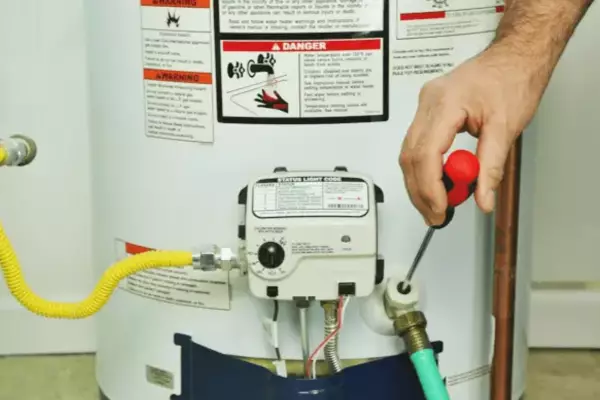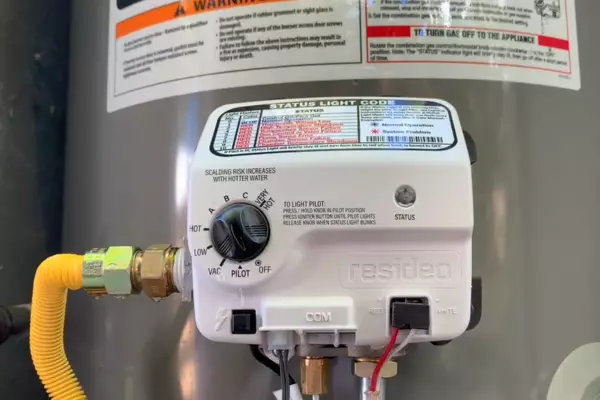Water heaters serve a crucial role in modern homes, providing hot water for various needs. Among the many types of water heaters, those with electronic pilots have gained popularity due to their efficiency and safety features.
The electronic pilot system operates differently from traditional ignition systems. Instead of a constantly burning pilot flame, electronic pilots ignite only when the heater is operational, saving energy and enhancing safety.
When it comes to maintenance, electronic pilots present a distinct scenario. Their unique design and functionality require specific handling procedures, particularly when reigniting the heater.
Contents
Essentials of Electronic Pilots
Electronic pilots are an innovative feature in modern water heaters. They are part of an ignition system that is a step up from traditional pilot lights in several ways.
Electronic Pilot Functionality
An electronic pilot is not a constantly burning flame, unlike traditional pilot lights. Instead, it operates by producing a spark that ignites the gas burner when you turn on the water heater. When the water heater is off, the pilot light also goes off, hence saving energy.
The electronic ignition system consists of several components:
- A control module that oversees the ignition sequence
- An igniter to produce the spark
- A flame sensor to confirm ignition and secure safety
When you start the water heater, the control module sends an electrical signal to the igniter, producing a spark. This spark lights the gas flowing from the burner, and the flame sensor confirms successful ignition.

Safety Features of Electronic Pilots
Modern water heaters have several safety features to prevent accidents. The electronic pilot system incorporates these features into its design:
- Flame Sensor: The flame sensor or flame rectification sensor is a safety device that checks whether the burner has ignited. If the sensor doesn’t detect a flame after the ignition cycle, it signals the control module to close the gas valve, preventing gas leaks.
- Thermal Switch: Some systems have a thermal switch that shuts off the gas supply if it detects unusually high temperatures, indicating a potential fire hazard.
- Pressure Relief Valve: While not part of the electronic pilot, the pressure relief valve is a vital safety feature on every water heater. It releases pressure from the tank if it becomes too high, preventing explosions.
Can You Manually Light a Water Heater With Electronic Pilot
Electronic ignition systems in modern water heaters are designed for safety and convenience, and as such, they do not support manual lighting. Attempting to light the pilot manually could result in damaging the unit or even posing a safety risk.
Exploring the Possibility
Traditional pilot lights could be manually lit, often using a long matchstick or a lighter. This isn’t the case with electronic pilots due to their design. Their operation relies on an electrical spark to ignite the gas, and manual lighting is not only unnecessary but also potentially dangerous.
Precautions and Safety Measures
Before attempting any form of maintenance or troubleshooting on your water heater:
- Turn off the gas supply to prevent leaks.
- Shut off the power supply to avoid electrical shocks.
- Wait for the water heater to cool down to prevent burns.
Always refer to the manufacturer’s instructions for any issues related to electronic pilot ignition. If the problem persists, professional assistance is recommended.
Gas Water Heaters and Electronic Pilots
Electronic pilots in gas water heaters provide a more efficient alternative to traditional pilot lights, reducing energy consumption and enhancing safety.
The Role of Electronic Pilots in Gas Water Heaters
Electronic pilots in gas water heaters serve two primary functions:
- They ignite the gas burner when there’s a need for hot water.
- They shut off when the heater is not in use, saving energy.
This intermittent operation differentiates them from traditional pilot lights, which remain lit continuously, consuming more energy.
Is It Possible: Light a Gas Water Heater with Electronic Pilot
While you cannot manually light an electronic pilot with a match or a lighter, you can reset or restart the system. This involves using the control panel on your water heater, which often has clear instructions for relighting the pilot.

Process: How to Light a Gas Water Heater With Electronic Pilot
While the exact process might vary depending on your water heater’s make and model, the general steps are similar across most units.
Step-By-Step Guide
Here is a basic guide on how to relight the electronic pilot on your gas water heater:
- Locate the Control Panel: This is typically at the bottom of your water heater. The panel should have a dial or a button for the pilot light.
- Switch off the Gas: Before starting, ensure the gas supply is off. This is an important safety measure to prevent gas leaks.
- Set the Dial to ‘Pilot’: On the control panel, turn the dial to the ‘Pilot’ setting.
- Press the Ignition Button: The ignition button, usually marked ‘Ignite’ or ‘Start’, sends an electric signal to the igniter to produce a spark. This spark lights up the gas from the burner.
- Verify Ignition: Listen for a clicking sound or watch for a flashing light on the control panel. These signals usually indicate successful ignition.
- Set the Dial to ‘On’: After the pilot light is on, turn the dial to the ‘On’ setting. The water heater will start heating water, and you should have hot water within a few minutes.
Troubleshooting Common Problems
If your water heater doesn’t reignite, you might be facing one of these common problems:
- Defective Ignitor: The ignitor might be broken or malfunctioning, preventing it from producing a spark.
- Faulty Control Valve: If the control valve isn’t opening, gas won’t reach the burner, and the pilot won’t light.
- Incorrect Gas Pressure: Too much or too little gas can prevent the pilot from staying lit.
- Dirty Pilot Orifice: A clogged pilot orifice can block gas flow, making it hard for the pilot to stay lit.
Electric Water Heaters and Electronic Pilots
While the terms “lighting a pilot” or “ignition” typically refer to gas-burning appliances, electric water heaters also utilize similar ignition principles. Unlike their gas counterparts, electric water heaters don’t use a flame for heating. Instead, they use electric resistance heating elements.
How Electric Water Heaters Work
An electric water heater heats water by running electricity through heating elements, similar to how an electric kettle works. Once the unit is switched on, electric current passes through the elements, causing them to heat up. The heat from the elements then transfers to the water in the tank.
The Role of Electronic Control Systems
The control system in an electric water heater is responsible for regulating the operation of the heating elements. When the thermostat senses that the water temperature has fallen below the set point, it sends a signal to the control system. The control system then activates the heating elements, which heat the water. Once the desired temperature is reached, the thermostat signals the control system to deactivate the heating elements.

Is It Possible: Ignite an Electric Water Heater
The concept of ignition, in the traditional sense, does not apply to electric water heaters. Since they do not burn fuel to produce heat, there is no need for a pilot light. However, turning on an electric water heater involves activating the heating elements.
How to Ignite Electric Water Heater
If your electric water heater is not heating water, there may be an issue with the heating elements or the control system. To “ignite” or activate the water heater, you need to identify and address these issues.
Checking the Circuit Breaker
A tripped circuit breaker could be the reason why your electric water heater is not working. Checking the circuit breaker is the first step:
- Locate Your Home’s Circuit Breaker Box: The water heater should have its dedicated circuit. Look for a switch that is not in line with the others.
- Reset the Circuit Breaker: If the water heater’s circuit breaker is tripped, switch it off and then back on again. This will reset the circuit and potentially restore power to the water heater.
Testing the Heating Elements
If resetting the circuit breaker doesn’t solve the issue, the heating elements may be faulty:
- Switch Off Power: For safety, ensure the power to the water heater is switched off at the circuit breaker.
- Locate the Elements: Heating elements are usually concealed behind panels on the side of the water heater.
- Test the Elements: You’ll need a multimeter to test the elements. If they are faulty, they’ll need to be replaced.
Inspecting the Thermostat
A faulty thermostat could also cause the water heater to fail:
- Locate the Thermostat: It is typically found behind a panel, similar to the heating elements.
- Test the Thermostat: Again, you’ll need a multimeter. If the thermostat is defective, it will not signal the heating elements to turn on and off as needed.
Frequently Asked Questions
Can I manually light an electronic pilot in a gas water heater?
No, electronic pilots in gas water heaters cannot be manually lit due to their design and safety features. They must be ignited using the control panel’s instructions.
Do electric water heaters have electronic pilots?
No, electric water heaters do not use electronic pilots or any kind of ignition system. They use electrical heating elements to warm the water.
What can I do if my water heater’s electronic pilot fails to ignite?
If your water heater’s electronic pilot fails to ignite, you can attempt to reset it following the manufacturer’s instructions. If this fails, seek professional help.
What is the lifespan of an electronic pilot in a water heater?
An electronic pilot is a part of the water heater’s control module, which typically lasts for the lifetime of the unit. This is around 10-15 years for most water heaters. However, if the electronic pilot fails before this time, it’s usually a symptom of a more significant issue with the control module.
Can I replace the electronic pilot in my water heater?
Typically, if the electronic pilot system in a water heater fails, it’s not the pilot that’s replaced, but the entire control module. This is a job for a professional, as it involves working with gas and electricity, which can be dangerous.
Can I convert my electric water heater to gas or vice versa?
Yes, but it’s not a simple switch. Converting an electric water heater to gas, or vice versa, involves changing out the entire unit. It also requires adapting your home’s infrastructure for the new heater. This conversion should always be done by a professional and is usually more expensive than replacing the unit with the same type.
Conclusion
Water heaters with electronic pilots exemplify advancements in home comfort technology, offering efficient and safe solutions for hot water needs. While the mechanisms of these systems are intricate, understanding their basic principles can help users operate them more effectively.
The inability to manually light electronic pilots in water heaters may seem inconvenient. However, this design aspect prioritizes safety and efficiency. It’s essential to adhere to the manufacturer’s instructions or engage professional services when troubleshooting issues.
Finally, with the continual evolution of technology, water heaters are becoming more user-friendly and safer. They stand as excellent examples of how technological advancements can offer practical, energy-efficient, and safe solutions for everyday needs.
